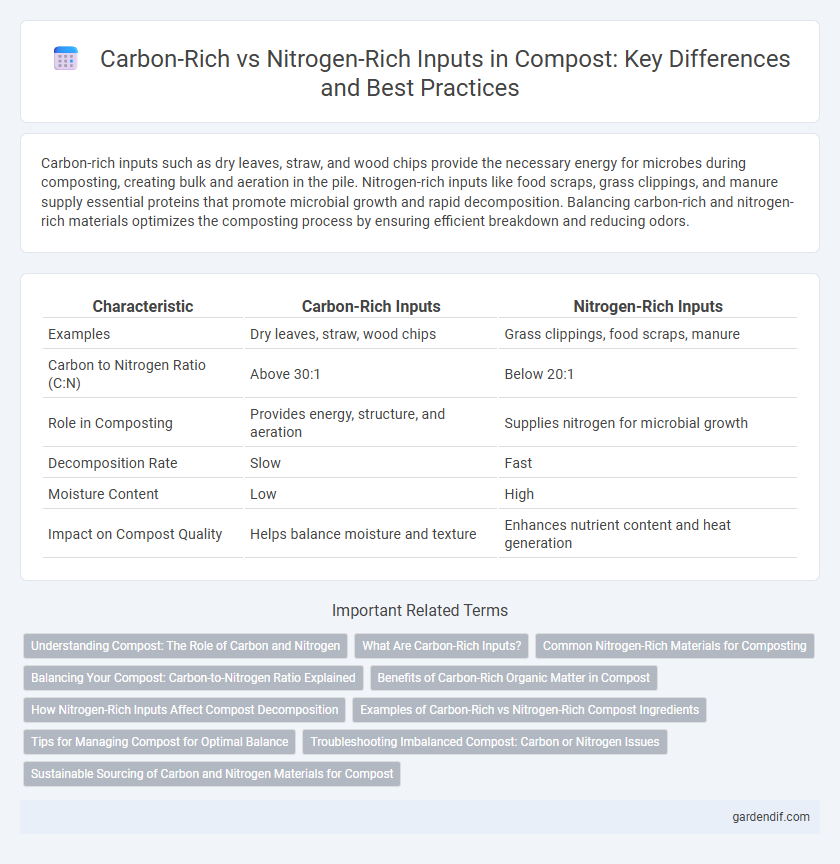
Carbon-Rich Inputs vs Nitrogen-Rich Inputs Illustration
Carbon-rich inputs such as dry leaves, straw, and wood chips provide the necessary energy for microbes during composting, creating bulk and aeration in the pile. Nitrogen-rich inputs like food scraps, grass clippings, and manure supply essential proteins that promote microbial growth and rapid decomposition. Balancing carbon-rich and nitrogen-rich materials optimizes the composting process by ensuring efficient breakdown and reducing odors.
Table of Comparison
| Characteristic | Carbon-Rich Inputs | Nitrogen-Rich Inputs |
|---|---|---|
| Examples | Dry leaves, straw, wood chips | Grass clippings, food scraps, manure |
| Carbon to Nitrogen Ratio (C:N) | Above 30:1 | Below 20:1 |
| Role in Composting | Provides energy, structure, and aeration | Supplies nitrogen for microbial growth |
| Decomposition Rate | Slow | Fast |
| Moisture Content | Low | High |
| Impact on Compost Quality | Helps balance moisture and texture | Enhances nutrient content and heat generation |
Understanding Compost: The Role of Carbon and Nitrogen
Carbon-rich inputs, such as dry leaves, straw, and paper, provide essential energy that fuels microbial activity during composting. Nitrogen-rich inputs, including kitchen scraps, grass clippings, and manure, supply proteins necessary for microbial growth and reproduction. Balancing the carbon-to-nitrogen (C:N) ratio, ideally around 30:1, optimizes decomposition by ensuring microorganisms receive both energy and nutrients efficiently.
What Are Carbon-Rich Inputs?
Carbon-rich inputs, also known as browns, consist of materials high in carbon such as dry leaves, straw, wood chips, and cardboard. These inputs provide the necessary energy for microorganisms during composting while balancing moisture and aeration in the pile. Maintaining an optimal carbon-to-nitrogen ratio, typically around 30:1, ensures efficient decomposition and prevents odors.
Common Nitrogen-Rich Materials for Composting
Common nitrogen-rich materials for composting include green plant waste, kitchen scraps like vegetable peels and coffee grounds, grass clippings, and manure from herbivores. These inputs typically have a low carbon-to-nitrogen (C:N) ratio, usually around 20:1 or lower, which accelerates microbial activity and decomposition. Incorporating adequate nitrogen-rich materials is crucial to balance carbon-heavy substances, ensuring an efficient composting process that produces nutrient-rich humus.
Balancing Your Compost: Carbon-to-Nitrogen Ratio Explained
Balancing your compost requires maintaining an optimal carbon-to-nitrogen (C:N) ratio of approximately 30:1 to promote efficient microbial activity and accelerate decomposition. Carbon-rich inputs, such as dry leaves, straw, and shredded paper, provide the energy source for microbes, while nitrogen-rich inputs like kitchen scraps, grass clippings, and manure supply essential proteins for microbial growth. Properly mixing these materials prevents odors, reduces ammonia loss, and results in nutrient-dense, high-quality compost for sustainable soil enrichment.
Benefits of Carbon-Rich Organic Matter in Compost
Carbon-rich organic matter in compost enhances microbial activity by providing a steady energy source, which supports the breakdown of complex materials and improves soil structure. High-carbon inputs like dried leaves and straw help balance nitrogen levels, preventing odors and promoting efficient decomposition. These materials also increase humus formation, boosting water retention and nutrient availability for plants.
How Nitrogen-Rich Inputs Affect Compost Decomposition
Nitrogen-rich inputs accelerate compost decomposition by providing essential nutrients that support microbial growth and activity, leading to faster breakdown of organic matter. High nitrogen content increases microbial protein synthesis, enhancing enzymatic processes that decompose carbon compounds more efficiently. Excess nitrogen can cause ammonia volatilization, requiring balanced carbon-to-nitrogen ratios to optimize composting performance and odor control.
Examples of Carbon-Rich vs Nitrogen-Rich Compost Ingredients
Carbon-rich compost ingredients include dry leaves, straw, wood chips, and cardboard, which provide essential carbon for microbial energy. Nitrogen-rich inputs such as grass clippings, food scraps, coffee grounds, and manure supply vital nitrogen that promotes microbial growth and accelerates decomposition. Balancing these materials in a ratio around 30:1 carbon to nitrogen optimizes composting efficiency and nutrient cycling.
Tips for Managing Compost for Optimal Balance
To achieve optimal compost balance, incorporate a mix of carbon-rich inputs like dry leaves, straw, and cardboard with nitrogen-rich materials such as vegetable scraps, grass clippings, and coffee grounds. Aim for a carbon-to-nitrogen ratio of approximately 30:1 to promote efficient microbial activity and faster decomposition. Regularly turning the compost and monitoring moisture levels help maintain aeration and prevent odors, ensuring an ideal environment for balanced nutrient breakdown.
Troubleshooting Imbalanced Compost: Carbon or Nitrogen Issues
Imbalanced compost often results from an incorrect ratio of carbon-rich inputs like dry leaves, straw, and cardboard to nitrogen-rich inputs such as grass clippings, food scraps, and manure. Excess carbon causes slow decomposition and dry, sock-like texture, while excess nitrogen leads to foul odors and wet, compacted material. Monitoring the ideal carbon-to-nitrogen ratio of approximately 30:1 ensures efficient microbial activity and successful compost breakdown.
Sustainable Sourcing of Carbon and Nitrogen Materials for Compost
Sustainable sourcing of carbon-rich inputs such as dry leaves, straw, and wood chips balances nitrogen-rich materials like kitchen scraps, green grass clippings, and manure in composting. Optimizing the carbon-to-nitrogen (C:N) ratio between 25:1 and 30:1 accelerates decomposition while minimizing greenhouse gas emissions. Utilizing locally sourced, renewable biomass reduces environmental impact and supports circular economy principles in organic waste management.
Carbon-Rich Inputs vs Nitrogen-Rich Inputs Infographic

 gardendif.com
gardendif.com